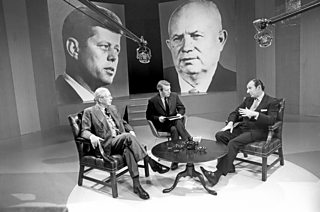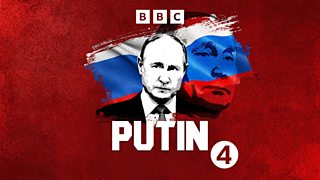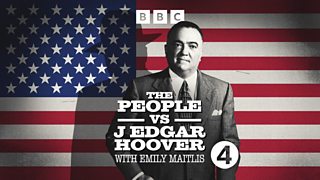Does nuclear deterrence work?
In The Nuclear Reckoning, a new mini-series from Sideways, broadcaster and journalist Matthew Syed argues that the thawing of the first Cold War has left us forgetful about the existential threat that still remains from the global nuclear arsenal.
Russia’s recent invasion of the Ukraine and President Vladimir Putin’s thinly veiled nuclear threats have been a wake-up call to the risks still posed by these weapons. But are we really heeding the danger?

Listen to Sideways. Matthew Syed goes inside a wargame to explore the evolution of deterrence.
Across the four episodes of the series, Matthew explores the intellectual and strategic frameworks, birthed by the bomb and the tensions of the Cold War, which sought to contain the ultimate destructive force.
From deterrence to disarmament and non-proliferation, keeping the nuclear threat at bay is a never-ending game of high stakes chess, a game we can never say we have finished playing.
Here we look at the notion of a deterrent, why it is not as simple as it first appears and the levels of thinking around it to make it a credible tool.
What is deterrence?
Nuclear strategy has revolved around the notion of deterrence since after the Second World War when the RAND [Research and Development] Corporation was set up to incorporate scientific research into American war planning.
The chief purpose of our military establishment must now be to avert wars.
A strategist called Bernard Brodie first articulated the concept of deterrence in 1946, just a year after the atom bomb was first used on Hiroshima and Nagasaki. “Thus far the chief purpose of our military establishment has been to win wars,” Brodie said. “From now on its chief purpose must be to avert them. It can have almost no other useful purpose.”
So, in other words, everyone is a loser in the event of an all-out nuclear war. The threat of it is what deters anyone from making the first move.
Scare tactics and "Dr Strangelove"
America's first major nuclear deterrent strategy was a 1954 policy devised by President Eisenhower's administration called ‘massive retaliation’. The premise was that any perceived threat – such as a non-nuclear incursion by Russia in Europe – would be dealt with by an all-out nuclear attack. It was a scare tactic, but to suggest a potentially apocalyptic war in response to any military action was not ultimately credible.
The crudeness of US nuclear policy was written about by RAND strategist Herman Khan in his 1960 book, On Thermonuclear War. In the book, Khan uses the term "Doomsday Machine" – a notion famously referenced in the 1964 film Dr Strangelove. In the film, the Doomsday Machine automatically launches nuclear weapons to destroy the earth if it detects a nuclear attack from the USSR (as it was then). Not only was Khan a major inspiration for Dr Strangelove, he was also an advisor to the film’s director, Stanley Kubrick.
Credible commitment
A cornerstone of Khan’s thinking on nuclear strategy was commitment. How far is a country willing to go? As he put it himself in a 1961 lecture: “I'm not even asking ‘are you willing to fight to the last man?’ I'm asking ‘are you willing to fight to the last woman and child?’”

So, not only did a country need to have weapons pointing at an adversary to frighten them off attacking, it needed to show them that you could survive a nuclear attack.
Khan’s work throws up a number of questions. If a nation is able to survive nuclear war, wouldn’t that make it more likely to launch one in the first place? And, if an adversary anticipates this, won't it get nervous and minded to get its attack in first?
These questions show that nuclear deterrence is, as Matthew describes, a “multi-dimensional poker game” where there are bluffs within bluffs.
War gaming
Following the Berlin crisis of 1961, after which the city was partitioned and the Berlin Wall was erected, the Kennedy administration enlisted the help of RAND strategist Thomas Schelling to run war game scenarios and help to untangle the bluffs and double bluffs.
Various scenarios were played out. However, despite the high stakes and escalating provocations, none of them resulted in nuclear war. This turned out to be more by accident than by design, as there was one other constant – both sides consistently misread each other’s intentions.
The Cuban Missile Crisis
Schelling’s work underlined the need for effective communication to make deterrence work.

This notion was tested in the most dramatic possible way with the Cuban Missile Crisis of 1962. The USSR wanted to bring missiles to Cuba so that it had weapons capable of reaching the US mainland. The US saw this as aggression, but the Soviets believed they were levelling the playing field and balancing out the deterrent threat of American missiles stationed in Turkey. The crisis played out over 13 days, during which time the world held its breath. The threat of conflict felt very real.
Kennedy balanced the different perceptions of the conflict by being bullish in public, giving an ultimatum to Soviet Premier Khrushchev, and in private, telling Khrushchev that the missiles would be destroyed if he didn’t withdraw them, but, if he, did, US missiles would leave Turkey within six months. It worked.
Mutually Assured Destruction
Schelling’s emphasis on communication also resonated with the emerging idea of nuclear conflict leading to "mutually assured destruction", known as MAD. This was a phenomenon that Schelling described as a "non-zero sum game", going against the conventional wisdom of war as a zero sum game, where one side wins outright and the other is totally defeated. In the nuclear age, both sides lost.
Though disaster was averted, the Cuban Missile Crisis spurred the USSR on to developing long-range missiles. So began a nuclear arms race, where both superpowers felt the need to escalate to a level playing field of mutually assured destruction, and thereby reaching a point where the world was sitting on a cumulative nuclear arsenal that could destroy it many times over.
Deterrence was entrenched as a tactical ploy on both sides. However, can it always be relied upon to deliver?
In the 1980s, President Ronald Reagan's administration decided to play a new war game. Once again, it was set up by Thomas Schelling. During the game, the American team fired off a hundred nuclear warheads in response to a conventional Soviet attack on western Germany. They aimed only at military targets, avoiding cities and hoping that the other team would read it as a warning signal. They didn’t. The result was MAD.
Does deterrence ultimately work?
After the atom bombs dropped on Hiroshima and Nagasaki at the end of the Second World War, the rules of combat changed. The nuclear age saw the object of war as to avoid one, not to win one: namely, deterrence.
Initially, the US interpreted deterrence crudely, equating a conventional attack by Russia as warranting a nuclear response. This wasn’t credible. However, credibility meant balancing a series of bluffs and mixed messages. For example, if you act as if you could survive a nuclear attack, wouldn’t you be more likely to launch one?
Communication between nuclear powers became a cornerstone of nuclear policy – helping to avoid misreading situations or underestimating the response from your adversary. JFK’s balancing of Khrushchev’s gambit and US public opinion during The Cuban Missile Crisis was the case study for this.
While deterrence remains the go-to nuclear policy, despite the prospect of "Mutually Assured Destruction" and keeping channels of communication open, there are no guarantees. As Matthew says: “I do worry deeply about an argument which says that the fact that a nuclear war hasn't happened proves that credible deterrence is without flaw.”
More to discover
-
![]()
Sideways
Best-selling author Matthew Syed explores the ideas that shape our lives with stories of seeing the world differently.
-
![]()
Putin
Jonny Dymond tells the extraordinary and revealing story of Vladimir Putin's life with the help of guests who have watched, studied and dealt with the Russian president.
-
![]()
The People vs J Edgar Hoover
An examination, half a century on from the first director of the FBI's death in office in 1972, of how Hoover's iron grip still permeates contemporary America.
-
![]()
In Our Time
Melvyn Bragg and his guests discuss the history of ideas - including topics drawn from philosophy, science, history, religion and culture.




